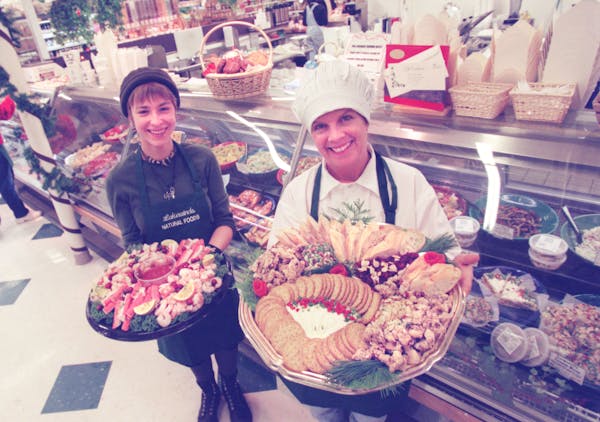For all kinds of reasons, the Twin Cities has been, and continues to be, an epicenter of the food co-op movement.
This fascinating evolution, from a niche counterculture offshoot to a mainstream economic and culinary force, has been chronicled in Taste.
(To mark the 50th anniversary of Taste — the section debuted in the Minneapolis Star on Oct. 1, 1969 — we are occasionally digging into its 2,600 past issues.)
The region's first food co-op sprouted in that hotbed of political activity, the West Bank neighborhood of Minneapolis. North Country Co-op was formed in 1971, a zero-frills storefront lined with bins for its buy-in-bulk membership.
If North Country shoppers were to time-travel to today's co-ops, they might take one look at their meat counters, juice bars, in-store bakeries, prepared-food spreads and other slick features and mistakenly believe they had stepped into a supermarket chain.
But then the co-op's abiding principles — member ownership, concern for community, an emphasis on sustainable farming practices and a focus on education and information-sharing — would come shining through.
The early co-op ventures featured a limited selection of vegetarian and vegan commodities, sold by weight or volume. Prices and overhead expenses were kept in check thanks to volunteer labor and consensus-building decisionmaking.
It seems unimaginable today, but in the mid-1970s, political and ideological allegiances were strong — and tempers ran hot — among various competing co-op groups, with flare-ups leading to occasional violent outbursts. One takeover attempt in 1976 resulted in four arrests, the firebombing of a truck (and an attempted firebombing of a store), plus a flurry of lawsuits and counter suits.
The friction between two opposing co-op forces inspired Minneapolis playwright Gemma Irish to write "The Co-op Wars," which received a staged reading last month at the Phoenix Theater in Minneapolis.
During the 1970s, food co-ops were in a definite growth mode. At their peak, there were more than 30 stores operating in the Twin Cities. Decline followed, driven in part by consolidation among locations.
Starting in the 1980s, co-ops began to more closely resemble their corporate supermarket competitors, phasing out their volunteer work options, switching from collective decisionmaking to more centralized management, adapting modern inventory practices and equipment, widening their food selections and expanding their stores' footprints.
At the same time, supermarkets began to borrow ideas from co-ops, adding bulk self-serve bins, expanding into organics and increasing ties to local producers.
At food co-ops, the bins are still there. But they've graduated from an earnest inventory of brown rice, granola and dried fruit to a dizzying array of foodstuffs: five types of quinoa, 25 whole-leaf teas, nine types of flour, 20 varieties of rice, grains, 190 bulk herbs and spices and all manner of pour-your-own vinegars, oils, molasses, kombucha and honey.
Here's a timeline, based on the newspaper's archive, with the writer indicated at the end.
1972: The new corner grocery store? The food cooperative movement not only is represented by the stores, but by a bakery, a warehouse and a mill which regularly grinds wheat, corn and rye and will grind other grains on order. The people at the stores, the bakery and the mill are not looking for a profit. Rather, they abhor it.
The driving principle of the cooperative food movement is to provide people with healthful food at as low a cost as possible. The food co-op may in time take the place of the "ma and pa" corner grocery store. In the face of supermarket competition, the "ma and pa" stores are disappearing, but there remains a need for them and the food co-op may supply the need. – Clifford D. Simak
1976: A profile of the Centennial Buying Club in Circle Pines, a cooperative of 35 member families buying unbleached whole-wheat flour, granola, nutritional yeast and other products, addressed how many food co-ops emerged from buyers' clubs. [Member Pete] Peterson sees the buying club as a steppingstone to a larger co-op store. "A buying club is only a start; you avoid licensing and other legal hassles and have a chance to develop a strong membership without all the investment of the store," he said.
His advice to fledging buying groups is to keep it small and organize it slowly; let it grow at its own pace. Probably the most difficult thing is getting a semblance of a homogenous group. He said that's why so many buying clubs are organized in churches and social clubs. "Once you have a cohesive group, you've covered a lot of problems," he said. – Peggy Katalanich
1977: The collaborative, pitch-in nature of early food co-ops was illustrated in a story on the fledgling Linden Hills Co-op. More than food has been offered at Linden Hills Co-op, 4303 Upton Av. S., since it opened a year ago. Friendship and community spirit have proved just as important as fresh vegetables, honey and peanut butter, according to its customers, worker-members and nonmembers alike.
"We have developed a real sense of community," said Allen Gibbs, a young lawyer and current president of Linden Hills' board of directors. "No one person is at the store all the time and yet the work gets done. A good system was set up, and it's working." – Ann Burckhardt
1978: Change was in the air. Food co-ops — once almost exclusively a counterculture refuge — have mellowed in aging. So much so that they now welcome, and indeed seek out, the 8-to-5ers with families and homes, who once were shunned by respectable co-op members. Co-ops, which grew out of the antiwar, counterculture movement of the late 1960s and early 1970s, found that to remain viable, successful, even (horrors) profitable, they needed to broaden their appeal beyond the relatively small group of alternative lifestylers in the Twin Cities. – Marybeth Buchele
1978: The mainstream grocery buying audience was still relatively unfamiliar with the co-op shopping process, as this story illustrates. Having the choice of foods, mostly unprocessed and additive- and preservative-free, is a big drawing card for many nutrition-conscious co-op shoppers. Others like bringing their own containers and bags and not paying for the extra packaging and bagging. And because most foods are sold in bulk, with the shopper packaging and weighing his purchases, it's simple to buy the exact amount you will use.
But a food co-op is not a supermarket. There is a relatively small number of items offered, a small fraction of the 6,000 to 8,000 items carried in a typical supermarket. Starting a co-op — either a storefront or a buying club — is probably easier than you think. To help get one started, Co-op Outreach, a committee drawn from all co-op ventures in the area, has pamphlets covering all aspects of operation. – Beth Anderson
1980: Food co-ops are becoming more user-friendly. The co-op concept is not new. But food co-ops created to serve a particular neighborhood were rare in the early '70s. In 1971, North Country Co-op became the first local food cooperative [it grew out of the People's Pantry, which was located on the back porch of a house in the West Bank neighborhood].
Co-ops cut across all ages, economic levels, political beliefs and professions. Because people are sometimes hesitant to ask how to use unfamiliar items, such as bulgur, tamari or kefir, the stores now have labels and fact sheets with use, storage and nutritional information. – Mary Gunderson
1982: Taste hails co-ops as the "general stores of the '80s." When you shop at a food co-op, you start down a new avenue in cooking. Along this path there are mung beans to sprout, tofu chunks to fry, unsweetened fruit spreads to taste, and herbs and spices to experiment with. It can lead to a new sense of adventure to your meals.
As the number of food co-ops in the Twin Cities has grown, so has the range of products at individual stores. Most started off with bins of grains, dried legumes, dried fruits, bottles of herbs and spices, a dairy cooler and a produce counter. And as the number of customers swelled, so did the selection. – Ann Burckhardt
1985: Food co-ops are taking their cues from their supermarket competitors. Times have changed, and so have the local food cooperatives. The soy grits and organic wheat berries are still there. But the shelves of the food cooperatives, long the mainstay for vegetarians in search of special provisions, are also stocked with taco seasoning, corn chips, spring water and gourmet coffee beans. One local co-op even carries the vegetarian's nemesis, meat.
"The coops aren't turning away from the staples," said Luddeen Perry, coordinator of the Twin Cities Co-op Association, a trade organization of 11 local coops. But for sales growth, they need those other items. "We have to supply what people want in '85, not what they wanted in '76 but no longer want."
Today, ideology has taken a back seat to diversity as the 22 area co-ops face stiff competition from the major groceries, which have taken heed of the natural foods market. – Lee Svitak Dean
1991: More of the above. "Most people's ideas of co-ops are pretty outmoded," said Gail Graham, general manager at Seward Co-op. "We've spent a great deal of capital on improving storefronts, on new computerized cash registers, better lighting and display. It's not cumbersome to shop at co-ops anymore." – Karin Winegar
2000: Food co-ops are in expansion mode, with eight out of 10 area co-ops in the throes of a major growth spurt. "It's simple," said E. Blake Ferris, owner services and market manager at Seward Community Co-op. "Natural and organic foods constitute the fastest growing segment of the food industry."
That growth is being fueled by a fundamental change in the way many Americans shop. "People are becoming much more educated about what they're consuming," said Eileen DonFrancesco, marketing and member services manager at Valley Natural Foods. "They're becoming more aware of what their choices are."
Juice bars, delis and meat departments are standard, and locally grown produce and locally made products are emphasized. "In a funny way, mainstream stores are helping us," said Jeanne Lasko, marketing and member services manager at Linden Hills Coop.
"By carrying natural and organic foods, they're making a broader variety of consumers aware of these food options. And then the consumers turn to the co-ops to buy them. In the end, we're all on the same page, because creating a greater demand for natural foods is better for everyone." – Rick Nelson
2014: On the occasion of Lakewinds Food Co-op opening its third location, in Richfield: The Lakewinds expansion is one example of the demand — and success — of the now-40-year-old co-op system. Minnesota has more than any other state, according to the National Cooperative Grocers Association, with Wisconsin coming in second.
While many of the elements of the early co-op days are reflected in Lakewinds' history, its biggest difference has to do with location. Lakewinds started in the suburbs at a time when most co-ops were opening in urban or rural areas. Perhaps the biggest change over the years is the number of products available that meet the co-op's mission about fresh, healthy, local and organic products.
"We see better selection today," said general manager Dale Woodbeck. "Shoppers today can use the co-op for one-stop shopping, if they choose to do so." That means there's charcoal and water softener at the co-op. De-icer for sidewalks that's not harmful to plants and animals. The Richfield store also offers a self-service juice machine, a coffee bar run by Peace Coffee, and a meat department that's not afraid to be visible.
"It's like an old-school butcher shop," said Dale Riley, senior operations manager. And then there's the design, light and bright and modern, with two murals from Adam Turman, a local artist. Yes, the times have changed. – Lee Svitak Dean
2019: The Twin Cities metro area is now home to nine member-owned food co-ops, operating in 15 locations:
Eastside Food Co-op (Minneapolis), Hampden Park Co-op (St. Paul), Harvest Moon Co-op (Long Lake), Lakewinds Food Co-op (Minnetonka, Chanhassen and Richfield), Mississippi Market Natural Foods Co-op, (three St. Paul locations), River Market Community Co-op (Stillwater), Seward Community Co-op (two Minneapolis locations), Valley Natural Foods (Burnsville), and the Wedge Community Co-op-Linden Hills Co-op (three Minneapolis locations).
Rick Nelson • @RickNelsonStrib
Metro-area food co-ops
1971:1
1973:5
1976:14
1978:24
1981:33
1982:31
1986:19
1991:16
2000:10
2019: 9
'Civil War' might be the year's most explosive movie. Alex Garland thinks it's just reporting
How many ballerinas can dance on tiptoes in one place? A world record 353 at New York's Plaza Hotel

Hugh Grant says he took 'enormous sum' to settle suit alleging illegal snooping by The Sun tabloid

Why you should donate clothing: It (probably) won't end up at the dump

